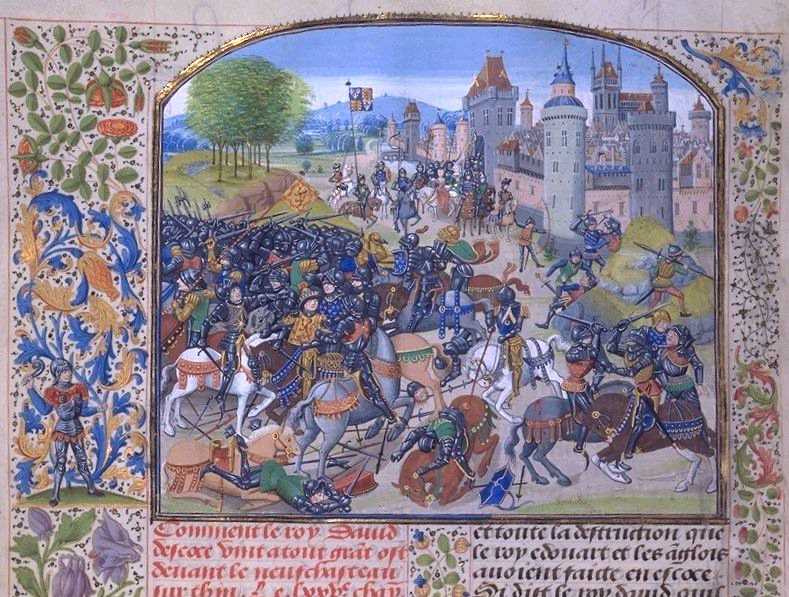History of the Stewarts | Battles and Historic Events
If you are a Stewart Society Member please login above to view all of the items in this section. If you want general information on how to research your ancestors and some helpful links - please look in background information.
If you have a specific question you can contact our archivist.

A picture of the Battle of Neville's cross from Froissant's Chronicles from the 15th century
On 7 October, the Scots invaded England with approximately 12,000 men. They were expecting to find northern England relatively undefended because Edward III was by then conducting a major campaign in France. (Philip VI went so far as to characterize northern England as a "defenceless void".) Unfortunately, David II´s strategic and tactical abilities were not up to the task of making good use of the Scots´ element of surprise.
After taking Liddesdale (and bypassing Carlisle after being paid protection money), the Scots moved on toward their ultimate goal of Durham and Yorkshire after more than a week´s march. Along the way, they sacked the priory of Hexham and burned the territory around their line of march. They arrived at Durham on 16 October and camped at Beaurepaire, where the Scots were offered £1,000 (£790,000 as of 2014) in protection money to be paid on 18 October.
Without the Scots´ knowledge, however, the English had already gathered troops for just such an invasion. Once the Scots invaded, an army was quickly mobilised in Richmond under the supervision of William Zouche, the Archbishop of York. It was not a large army and what men were available were split into two separate groups: 3,000–4,000 men from Cumberland, Northumberland and Lancashire, with another 3,000 Yorkshiremen en route. Given the demands of the Siege of Calais, no further men could be summoned for the defence of Northern England. Worse still, on 14 October (while the Scots were sacking Hexham), the Archbishop decided not to wait for the Yorkshiremen and made haste toward Barnard Castle.
After their defeats at Halidon Hill and Dupplin Moor, the Scots tried to take a defensive stance , waiting for the English advance but the English pushed the Scottish line with archers and forced an attack. Their formations disrupted, the Scottish advance was easily dealt with, and Robert Stewart, future king of the Scots and the earl of March fled the battlefield, abandoning David II´s battalion to face the enemy alone. Late in the afternoon, the king´s own battalion attempted to retreat, but was unsuccessful and David II was captured after he fled the field, while the rest of the Scottish army was pursued for more than twenty miles and many were captured.
The defeat at Neville´s Cross was a disaster for the Scots since not only was the king killed but in 1347 the English were able to occupy whole of Scotland south of the Forth and the Clyde.
Reference: Neville's Cross Battlefield Trust

